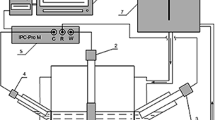Summary
The speciation of Cu with morpholine (tetrahydroxo-1,4-oxazine) was studied in alkaline solutions bydc- and differential pulse polarography. In the pH range 8.7–9.8 Cu forms a mixed morpholinehydroxo complex which is reduced reversibly at the dropping mercury electrode by the uptake of 2 electrons. By the evaluation procedure of Fisher and Hall for the half-wave potential shift of a metal ion complexed with two different types of ligands the ligand number for hydroxide and morpholine and the stoichiometric complexity constant have been determined fromdc-polarographic and differential pulse polarographic data. The resulting values indicate the formation of a Cu(II) complex containing one hydroxide and two morpholine groups. From the visible spectra and the ESR-spectra the monomeric [CuL2(OH)(H2O)3]+ with octahedral structure emerges as the only possible structure and the formation of a dimer is clearly excluded. The average value of the stability constant is about 1018 and indicates a stronger binding than that for the Cu-ammonia-complex of the same sterical configuration. The strong complexation of Cu with morpholine in boiler waters of power stations containing morpholine as a pH regulating anticorrosive agent may have significant consequences on the chemical speciation of Cu in effluent waters and consequently on the Cu-uptake by planktonic species in natural waters into which those effluent water is discharged.
Zusammenfassung
Die Komplexierung von Cu mit Morpholin (Tetrahydroxo-1,4-oxazin) wurde in alkalischer Lösung mit der Gleichstrompolarographie und der differentiellen Pulspolarographie untersucht. Im pH-Bereich 8,7–9,8 bildet Cu einen gemischten Morpholinhydroxokomplex, der an der Quecksilbertropfelektrode unter Aufnahme von 2 Elektronen reversibel reduziert wird. Die Ligandenzahl für das Hydroxid und das Morpholin und die stoechiometrische Stabilitätskonstante wurden aus der Verschiebung des Halbstufenpotentials nach der Methode von Fischer und Hall berechnet.
Die Resultate weisen auf die Bildung eines Cu(II)-Komplexes mit einem Hydroxid- und zwei Morpholinliganden hin. Auf Grund der Untersuchung der optischen Spektren im sichtbaren Bereich und der ESR-Spektren liegt die monomere Struktur [CuL2(OH) (H2O)3]+ mit einer oktaedrischen Konfiguration in der Lösung vor. Die Bildung eines Dimers ist auf Grund der optischen Untersuchungen ausgeschlossen. Der Mittelwert der Stabilitätskonstante beträgt etwa 1018 und weist auf eine viel stärkere Bindung als beim Cu-Ammoniak-Komplex mit der gleichen sterischen Konfiguration hin. Die starke Komplexierung von Cu mit dem Morpholin, das im Kesselspeisewasser der Kraftwerke als pH-regulierendes Antikorrosionsmittel eingesetzt wird, kann einen wesentlichen Einfluß auf die chemische Verbindungsform von Cu und dadurch auf die Aufnahme von Cu durch das Plankton in natürlichen Gewässern im Einleitungsbereich von Kraftwerksabwasser ausüben.
Similar content being viewed by others
References
M. v. Stackeiberg and H. v. Freyhold, Z. Elektrochemie46, 120 (1940).
J. L. Hall, R. B. Simmons, E. Morita, E. Joseph, and J. G. Gavlas, Analyt. Chemistry43, 634 (1971).
N. C. Li, J. M. White, and E. Doody, J. Amer. Chem. Soc.76, 6219 (1954).
H. A. Laithinen, E. I. Onstott, J. C. Bailov, Jr. and S. Swann, Jr., J. Amer. Chem. Soc.71, 1550 (1949).
I. A. Korshunov and N. I. Malyngina, Zh. obshch. Khim.20, 402 (1950).
D. R. Crow and J. V. Westwood, J. Inorg. Nucl. Chem.30, 179 (1968).
R. M. Keefer, J. Amer. Chem. Soc.66, 2329 (1946).
P. Valenta in G. C. Leppard (ed.), Trace Element Speciation in Surface Waters and Its Ecological Implications, Part I, New York: Plenum Press (in press).
H. W. Nürnberg in G. C. Leppard (ed.), l. c. 8, Part II (in press).
H. W. Nürnberg and B. Raspor, Environm. Technol. Lett.2, 457 (1981).
L. Sipos, P. Valenta, H. W. Nürnberg, and M. Branica, in M. Branica, Z. Konrad (eds.), Lead in the Marine Environment, Oxford: Pergamon Press. 1980. p. 61.
S. V. Narasimhan and P. Valenta, in preparation.
R. E. Mesmer and B. F. Hitch, J. Solution Chem.6, 251 (1977).
D. R. Crow, Polarography of Metal Complexes, London: Academic Press. 1969.
J. F. Fisher and J. L. Hall, Analyt. Chemistry34, 1094 (1962).
G. A. Heath and G. Hefter, J. Electroanal. Chem.84, 295 (1977).
E. P. Parry and R. A. Osteryoung, Analyt. Chemistry37, 1635 (1965).
G. C. Barker and A. W. Gardner, AERE Harwell Report C/R 1786 (1955); Z. analyt. Chem.173, 79 (1960).
F. A. Cotton and G. Wilkinson, Advanced Inorganic Chemistry, New York: Wiley. 1966.
L. G. Sillén and A. E. Martell, Stability Constants of Metal Complexes, Chem. Soc. (London) Spec. Publ. 17 (1964) 25 (1971
M. Kato, Chem. Rev.64, 99 (1964).
J. R. Pilbrow, A. D. Toy, and T. D. Smith, J. Chem. Soc. (A)1969, 1029.
Author information
Authors and Affiliations
Rights and permissions
About this article
Cite this article
Narasimhan, S.V., Valenta, P. Determination of the speciation of copper in the presence of morpholine in alkaline solutions by DC and differential pulse polarography. Mikrochim Acta 80, 297–311 (1983). https://doi.org/10.1007/BF01213124
Received:
Issue Date:
DOI: https://doi.org/10.1007/BF01213124



